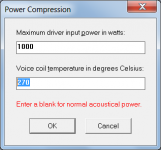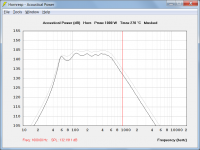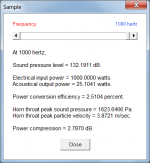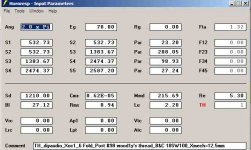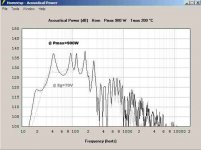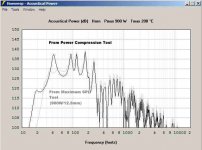That brings me right back to where I started. Why not just play the driver as intended, get it hot and measure the t/s parameters while hot? That's going to give better results than just measuring the increased Re. We've always had the ability to do this.
Seems to me some of us didn't want to measure t/s parameters while hot so a "guessing" feature was proposed. Now that the guessing feature has been shown to be not too useful a temp measurement device is being proposed, but this new device is still not as useful or easy as just measuring the t/s parameters in the state that they are going to be used.
If you have the driver and / or have built the system, sure, heat it up and measure it. Of course if you've built the whole system, you just measure that - no need to simulate. But a lot of the time I (and I'm sure others) use HR to look at what we can do with drivers we haven't bought in order to decide whether or not we want to buy them and build a system. That's where a 'guess' would be helpful. It's not totally necessary - you could just create a new record with a driver with higher DCR and see what it does.
VC temperature varies with the signal level and also near instantaneously with the signal current waveform.
Power compression is not just a sensitivity change. It is a distortion effect. It soft clips, or rounds off, the peaks of the very high signals.
Power compression is not just a sensitivity change. It is a distortion effect. It soft clips, or rounds off, the peaks of the very high signals.
Some manufacturers state the powercompression in the datasheet, so this information is available for 18Sound, Beyma, etc.. At least in the measuerment situation (IEC Baffle or stated enclosure used by the manufacturer to test the driver). Of course this figure can change dramatiucally in a enclosure, differing from the different types of enclosures (a closed Box will behave very different than a tapped horn than a frontloaded horn with a small rear chamber than a dipole, etc...).
Klippel does measure drivers in high SPL state and many of the pro Sound drivers show, that specs are not so far away from the traditional 2,83V Measuerement, if the driver is driven within a "sane" range. Of course nowadays its comon to push drivers to the outmost limit where parameters change a lot - but to be sure what really happens one has to check the final box, its almost impossible to predict with a simulation what exactly will happen.
Klippel has a mathematical model to simulate what will happen in a driver when driven at high power, thats correct. But even this model is not capable to cope with every aspect of the driver in terms of non-linearities at very high power. Its just better than the tradtionional models (as is the LEAP Set of data, or as LSP Cad is capable of....).
Any "normal" driver used today in a enclosure suffers from almost the same set of non-linearities at high power when driven hard. Some more, some less. What happens if the signal is compensated can be heard if you listen to a sensor-controlled System. In Germany we have CODA Audio which use soime 18" drivers in a closed enclosure and sensors to check what the cone realy does - it "knows" where the voice coil actually is. This enables the drivers to work very exact at very high excursion levels and power compression effects (regardless where it comes from) are almost eliminated in the end. This results in extreme SPL with very low distortion - very impressive. IPAL transducers from B&C, 18Sound and powersoft amps join up to do similar things in some other cabs, Foeoen, Meyer and others have systems with sensor controlling...
Back to topic:
Measuring the Re increase in the voice coile by simply measrurgin current etc.. of course is possible. This can show you the heat up of the coil and the resulting Change of Qts, Qes etc... in realtime. This helps of course in finding more about the system - but its not enough information to get the whole picture of what is happening - real coil movement, beraking up of the cone etc.. is not visible by this method. So you still have a lot of factors not included.
Because it is so difficult to simulate everything neede to know to exactly predict what will happen at high power - it is easier to simply build up a prototype and see what happens. In my experience, most manufacturers don´t even bother to really measure what happens - they just state the Max Watt of the drivers in the system (maybe marketing adds some.....) and use the speakers a while and see if they last. If they don´t they use "bigger drivers"....
Klippel does measure drivers in high SPL state and many of the pro Sound drivers show, that specs are not so far away from the traditional 2,83V Measuerement, if the driver is driven within a "sane" range. Of course nowadays its comon to push drivers to the outmost limit where parameters change a lot - but to be sure what really happens one has to check the final box, its almost impossible to predict with a simulation what exactly will happen.
Klippel has a mathematical model to simulate what will happen in a driver when driven at high power, thats correct. But even this model is not capable to cope with every aspect of the driver in terms of non-linearities at very high power. Its just better than the tradtionional models (as is the LEAP Set of data, or as LSP Cad is capable of....).
Any "normal" driver used today in a enclosure suffers from almost the same set of non-linearities at high power when driven hard. Some more, some less. What happens if the signal is compensated can be heard if you listen to a sensor-controlled System. In Germany we have CODA Audio which use soime 18" drivers in a closed enclosure and sensors to check what the cone realy does - it "knows" where the voice coil actually is. This enables the drivers to work very exact at very high excursion levels and power compression effects (regardless where it comes from) are almost eliminated in the end. This results in extreme SPL with very low distortion - very impressive. IPAL transducers from B&C, 18Sound and powersoft amps join up to do similar things in some other cabs, Foeoen, Meyer and others have systems with sensor controlling...
Back to topic:
Measuring the Re increase in the voice coile by simply measrurgin current etc.. of course is possible. This can show you the heat up of the coil and the resulting Change of Qts, Qes etc... in realtime. This helps of course in finding more about the system - but its not enough information to get the whole picture of what is happening - real coil movement, beraking up of the cone etc.. is not visible by this method. So you still have a lot of factors not included.
Because it is so difficult to simulate everything neede to know to exactly predict what will happen at high power - it is easier to simply build up a prototype and see what happens. In my experience, most manufacturers don´t even bother to really measure what happens - they just state the Max Watt of the drivers in the system (maybe marketing adds some.....) and use the speakers a while and see if they last. If they don´t they use "bigger drivers"....
But a lot of the time I (and I'm sure others) use HR to look at what we can do with drivers we haven't bought in order to decide whether or not we want to buy them and build a system. That's where a 'guess' would be helpful.
Hi John,
Just to confirm - are you saying that a power compression feature in Hornresp, using Pmax and voice coil temperature as inputs, would be of use to you, and possibly others?
If so, would it be more realistic to reduce the upper temperature limit from 270 deg C to 200 deg C, which as far as I can determine seems to be the generally accepted design target maximum?
Kind regards,
David
I can add in two cents worth of information with the following.
The majority of drivers use adhesives that are getting pretty soft even around 200 Celsius. At 270 Celsius your coil to former joint is starting to give way. Literally slipping up or down the former.
So to the point. 200 degrees Celsius is already pretty much the real world top end.
There are drivers that can be used a little hotter. But not that many.
The majority of drivers use adhesives that are getting pretty soft even around 200 Celsius. At 270 Celsius your coil to former joint is starting to give way. Literally slipping up or down the former.
So to the point. 200 degrees Celsius is already pretty much the real world top end.
There are drivers that can be used a little hotter. But not that many.
While I understand why voice coil temperature could be considered a somewhat imprecise input parameter, like any other Hornresp input, if the value is accurate then the calculated result (in this case power compression) will be accurate.
Kind regards,
David
Hi John,
Just to confirm - are you saying that a power compression feature in Hornresp, using Pmax and voice coil temperature as inputs, would be of use to you, and possibly others?
Kind regards,
David
Just a couple of extra notes here. First, regarding the second quote, I don't expect any opinions I've provided here to be counted as a vote, they are just IMO and that's all. Your vote is the only one that counts. If you want this feature, put it in. Nobody is going to complain after the fact. To be honest I might even use it occasionally.
Regarding the first quote, this gets deeper into the reasons I didn't like the idea of including it.
NOTHING on the Input screen is an imprecise input parameter. Ang is not imprecise, Eg can be measured, ALL the segment definitions can be precisely measured, the t/s parameters can be measured, the chamber sizes and shapes can be measured, and even the stuffing parameter is not imprecise. There's no need to guess at any input on the Input screen, nothing is imprecise. (You could argue that Eg is problematic because it can't account for the wide variety of signals and crest factors that can be applied to a speaker, but technically Eg itself is not imprecise, it can be measured.)
Despite that the resulting sim will produce errors based on things not accounted for. Power compression is one, less than infinitely stiff building materials introducing losses is another, port compression is another. We know these issues exist, and knowing there isn't a lot you can do about it, we are happy to live with these errors.
Trying to make corrections to these limitations is another thing entirely. If a correction is to be attempted, you could reasonably expect that you could input a precise input (like all the other precise inputs) and the correction would be accurate. That is not at all what is going to happen with the power compression correction proposed. There's no way to accurately identify the temperature and therefore there's no way to make sure the correction is accurate.
Combine the imprecise nature of the correction with the fact that the correction isn't complicated (it isn't anything we can't easily enter manually) and it doesn't seem to make much sense to add it as a formal feature.
IMO.
The fact that it could be misleading to new users is secondary, all they need to do is read the instructions like everybody else.
Go ahead and add the feature if you want it.
Hi Mark & just a guy,
Thanks for your further comments.
Just to explain, I have tried to make Hornresp both a simulation tool and a learning tool. The power compression feature, if included, would fall more into the learning category. Users could quickly get a sense of how voice coil temperature affected power output - I suspect some might even discover that the reduction in output is not as great as they had first anticipated.
Specifying the temperature as 200 deg C, while it might not be exactly accurate, would probably represent the worst case scenario in terms of power lost, which could be useful to know.
I will give it some more thought, and make a decision on whether or not to include the tool.
Kind regards,
David
Thanks for your further comments.
Just to explain, I have tried to make Hornresp both a simulation tool and a learning tool. The power compression feature, if included, would fall more into the learning category. Users could quickly get a sense of how voice coil temperature affected power output - I suspect some might even discover that the reduction in output is not as great as they had first anticipated.
Specifying the temperature as 200 deg C, while it might not be exactly accurate, would probably represent the worst case scenario in terms of power lost, which could be useful to know.
I will give it some more thought, and make a decision on whether or not to include the tool.
Kind regards,
David
Regarding power compression I would like to be able to simulate at what sound levels it becomes noticeable.
Since the simulation is very much dependent on how a driver is manufactured and how heat is transported from the box it will be more of a learning exercise than a prediction.
But if we can link simulation to measurement maybe we can reuse some driver parameters as well as generic box properties between projects.
Since the simulation is very much dependent on how a driver is manufactured and how heat is transported from the box it will be more of a learning exercise than a prediction.
But if we can link simulation to measurement maybe we can reuse some driver parameters as well as generic box properties between projects.
It might be cool to have something like "Estimated power compression at xxx degrees", as long as it's not trying to guess temperature based on power input, which I'd imagine would be nearly impossible to accurately guess because of un-knowables, like pole piece venting or ambient temperature inside the cab, or even humidity.
I could maybe see something that requires a few different actual temp readings, say measuring it after 1v / 5 min and again at 5v / 5 min and then using the two temps to estimate a curve perhaps?
I dunno, it seems like it might be rather difficult to get a number that means much.
Edit: I've often thought that driver manufacturers should include a thermal sensor on the vc for drivers over a certain power handling.
I could maybe see something that requires a few different actual temp readings, say measuring it after 1v / 5 min and again at 5v / 5 min and then using the two temps to estimate a curve perhaps?
I dunno, it seems like it might be rather difficult to get a number that means much.
Edit: I've often thought that driver manufacturers should include a thermal sensor on the vc for drivers over a certain power handling.
Last edited:
Hi Mark & just a guy,
Thanks for your further comments.
Just to explain, I have tried to make Hornresp both a simulation tool and a learning tool. The power compression feature, if included, would fall more into the learning category. Users could quickly get a sense of how voice coil temperature affected power output - I suspect some might even discover that the reduction in output is not as great as they had first anticipated.
Specifying the temperature as 200 deg C, while it might not be exactly accurate, would probably represent the worst case scenario in terms of power lost, which could be useful to know.
I will give it some more thought, and make a decision on whether or not to include the tool.
Kind regards,
David
I agree that the power compression tool could be a learning tool.
An interesting one at that.
The next question would be a simulated sine wave at what duty cycle?
Or a simulated pink noise to approximate musical use?
The results are very different.
I may have a paper on the differences. That is if memory serves me. It tends to have a mind of it's own...
Maybe these will see the light of day at some point:
PREORDER VCi-1 Infrared Voicecoil Temperature Sensor
PREORDER VCi-1 Infrared Voicecoil Temperature Sensor
Hi Mark & just a guy,
Thanks for your further comments.
Just to explain, I have tried to make Hornresp both a simulation tool and a learning tool. The power compression feature, if included, would fall more into the learning category.
Kind regards,
David
Well now, that's completely different. That's a whole different philosophical perspective of what Hornresp actually is.
In that case the feature is totally appropriate.
Hi Everyone,
Thanks for your latest comments - you have made the decision very easy for me - I will include the power compression feature 🙂
The upper temperature limit will probably be left at 270 deg C though, rather than being reduced to 200 deg C as recently proposed. From what I can gather, 270 deg C appears to be an acceptable voice coil temperature for some of the more "extreme" high-power bass drivers. This higher limit will also give users more scope to experiment with different values.
I will include a suitable cautionary note in the Help file.
Kind regards,
David
Thanks for your latest comments - you have made the decision very easy for me - I will include the power compression feature 🙂
The upper temperature limit will probably be left at 270 deg C though, rather than being reduced to 200 deg C as recently proposed. From what I can gather, 270 deg C appears to be an acceptable voice coil temperature for some of the more "extreme" high-power bass drivers. This higher limit will also give users more scope to experiment with different values.
I will include a suitable cautionary note in the Help file.
Kind regards,
David
Hornresp Update 3630-141108
Hi Everyone,
CHANGE
The Power Compression tool has now been added, and can be accessed from the Acoustical Power window. See the Hornresp Help file and previous posts starting from #5027 for further details. Thanks to all those who contributed to the development of this feature.
Kind regards,
David
Hi Everyone,
CHANGE
The Power Compression tool has now been added, and can be accessed from the Acoustical Power window. See the Hornresp Help file and previous posts starting from #5027 for further details. Thanks to all those who contributed to the development of this feature.
Kind regards,
David
Attachments
Hi David,
I've looked at a number of simulations, and it looks like your new Power compression tool uses constant electrical input power. Would it not be better to use constant electrical input voltage?
Thanks for the new tool.
Regards,
I've looked at a number of simulations, and it looks like your new Power compression tool uses constant electrical input power. Would it not be better to use constant electrical input voltage?
Thanks for the new tool.
Regards,
I've looked at a number of simulations, and it looks like your new Power compression tool uses constant electrical input power. Would it not be better to use constant electrical input voltage?
Hi Oliver,
I decided to use Pmax rather than Eg because I assumed that the driver voice coil would be most likely to reach its highest operating temperature under conditions of maximum input power. In some ways, it is similar to the thinking behind the Maximum SPL tool.
Otherwise, a user could specify an input voltage Eg of 2.83 volts, but with a temperature of 200 deg C, which would not be a realistic combination. Far more than 2.83 volts would be required to heat the voice coil to 200 deg C.
It would certainly have been easier for me to use Eg as the input, because it is already specified on the main input screen 🙂.
What do others think - Pmax and Tmax as the inputs, or just Tmax, with the value of Eg coming from the main screen?
It has to be one option or the other - it can't be both 🙂.
Kind regards,
David
Your new tool with Pmax and T
Gray is a small Tapped Horn with Eg=90V=1000W in 8 Ohm

and this is, what we want to know
Eg=90V and Rg=half of Re=T of 170°C

Gray is a small Tapped Horn with Eg=90V=1000W in 8 Ohm

and this is, what we want to know
Eg=90V and Rg=half of Re=T of 170°C

Power Compression Tool
Hi David,
I would prefer to see a power compression curve derived from the same Eg as the original SPL curve. The user will have to guess at the temperature anyway to arrive at a realistic result.
This would also allow the simulation to be compared to a measurement as most drive amplifiers will work w/ a constant voltage output, not a constant power output.
I would see this as a more meaningful simulation, particularly for enclosures that have very large impedance changes.
I'll attach a TH example.
Regards,
Hi David,
I would prefer to see a power compression curve derived from the same Eg as the original SPL curve. The user will have to guess at the temperature anyway to arrive at a realistic result.
This would also allow the simulation to be compared to a measurement as most drive amplifiers will work w/ a constant voltage output, not a constant power output.
I would see this as a more meaningful simulation, particularly for enclosures that have very large impedance changes.
I'll attach a TH example.
Regards,
Attachments
I vote for Eg.
It is used in the input screen and is the figure we work with from the get go.
Max power will end up being even more confusing to someone who is not familiar with the program.
It is used in the input screen and is the figure we work with from the get go.
Max power will end up being even more confusing to someone who is not familiar with the program.
I will wait a day or so longer to see if there is any more feedback, but at this stage it is looking like a change from Pmax to Eg for the Power Compression tool 🙂.
- Home
- Loudspeakers
- Subwoofers
- Hornresp
